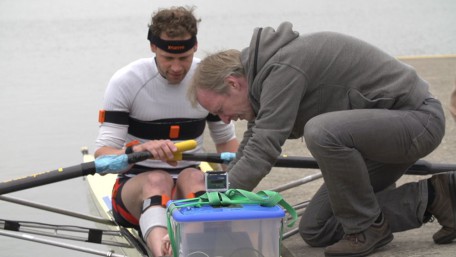HOT
 Production-Quality Lenses Directly from SLA 3D P…
Production-Quality Lenses Directly from SLA 3D P… Forging Ahead with Solar Energy and GibbsCAM CNC…
Forging Ahead with Solar Energy and GibbsCAM CNC… GibbsCAM Software Helps Race-Team Mechanics Beco…
GibbsCAM Software Helps Race-Team Mechanics Beco… Metro Aerospace Introduces 3D Printed Part for F…
Metro Aerospace Introduces 3D Printed Part for F… GibbsCAM Enables Rover Exploration Vehicle Parts…
GibbsCAM Enables Rover Exploration Vehicle Parts… Designing a Custom Boot for an Injured Penguin
Designing a Custom Boot for an Injured Penguin Asano Uses Geomagic 3D Scan Software to Drive In…
Asano Uses Geomagic 3D Scan Software to Drive In…
Rowing with Xsens MVN
Chris Baten and his team at Roessingh Research & Development (RRD), in Enschede, the Netherlands investigate the technological and methodological (im)possibilities of an application for coaching in competitive rowing (using inertial sensing data from the MVN BIOMECH system). They recently have tested their solution on open water at the Bosbaan Amsterdam in strong collaboration with rowing research specialists Mathijs Hofmijster and Lotte Lintmeijer and their students of the Vrije Universiteit of Amsterdam. Several studies at rowing clubs Proteus Delft and Euros Enschede (Lloyd van Hout) preceded those series of experiments.

Over the last 20 years the research group ‘Ambulatory 3D Motion Analysis’ at RRD has pioneered ambulatory methodologies and applications of inertial sensing. Apart from applications in rehabilitation and ergonomics, RRD also targets applications in sports injury prevention and sports performance. For this RRD cooperates closely with an array of other scientific and industrial partners e.g. organized in the Dutch Fusion research consortium.
Simultaneously the group at the Vrije Universiteit has build up a strong research on the biomechanics of rowing.

Application in rowing
In collaboration with the Vrije Universiteit of Amsterdam, RRD is currently investigating the technological and methodological possibilities for coaching in competitive rowing. The aim is to develop a tool that provides sufficiently accurate, relevant information to the rowing coach about the exact timing and coordination of the rowers during actual rowing on the water. Recently, a biomechanical analysis of power generation mechanisms and a direct estimation of instantaneous power output are added.
Such information is otherwise very hard or even impossible for the rowing coach to obtain and assess. This valuable source of information is available to the coach, to aid coaching decisions and activities. Moreover, the tool can be used in real time, or, if desired, in discussions with the rowers afterwards.
First results of these studies were already discussed with members of the Dutch rowing community during workshops in Delft in the autumn of 2007. Several scientific presentations followed over the years in conferences on (sports-)biomechanics, most recently at the ISB and ISBS conferences in 2015. Several scientific papers are in preparation and will appear in 2016.

Methods
The rowing coach application was initially derived from a combination of two other devices, the IC-Coach and the ACL-Coach. The IC-Coach is an application, developed for coaching low back pain patients in back loading behavior, and ACL-Coach for monitoring and coaching ACL surgery patients.
In this case, the coach application consists of full body inertial sensing data from the MVN BIOMECH (Awinda) suit with additional sensors on both oars and the boat and force sensors in the oar handles, combined with 2 synchronized wireless camera video streams and a first choice of essential graphics. All data was recorded in the boat during actual rowing on the open water.

More info
Chris Baten – Group 3D Ambulatory Motion Analysis, Roessingh Research and Development.
Acknowledgement
Thanks to Rowing Clubs, Proteus Eretes Delft, Okeanos Amsterdam and Euros Enschede.
Thanks to master students Marieke Vervoert, Remon van de Aa, Fred Vuijk, Mats Baten (RRD) and Guido Schulte and Patrick Zijlstra (Vrije Universiteit).




































